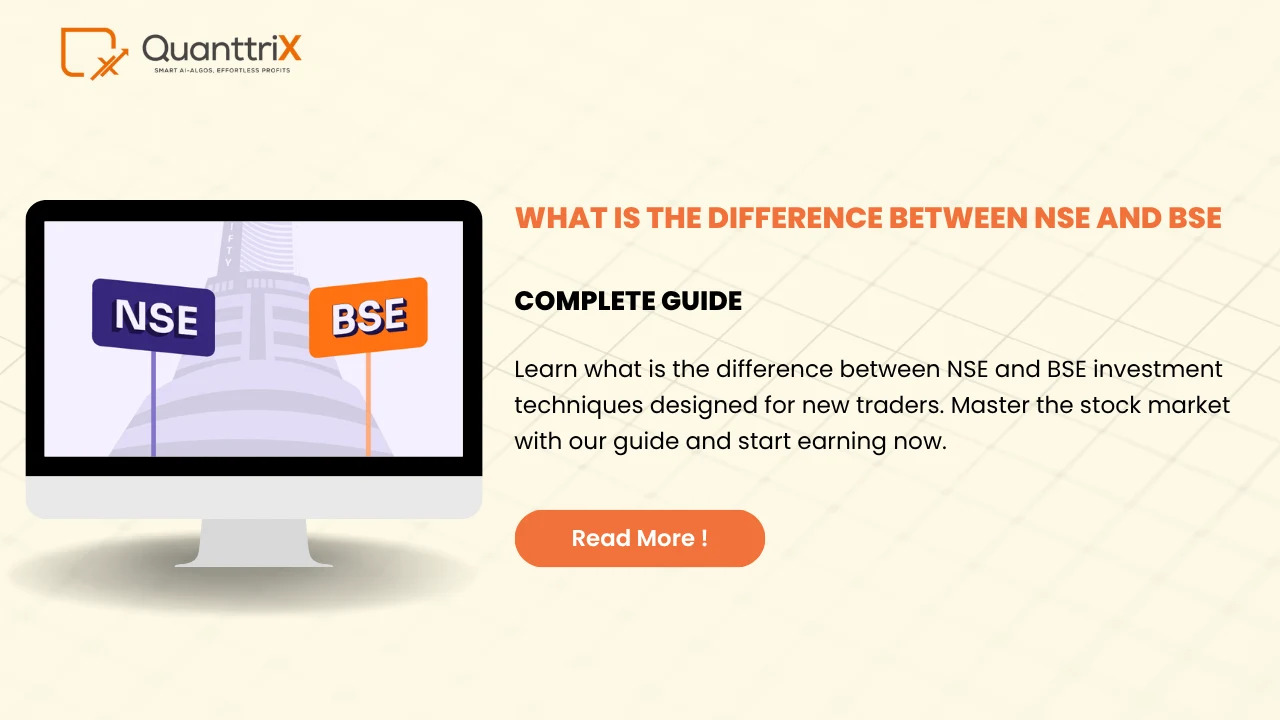What is the Difference Between NSE and BSE?
Are you curious about the stock market buzzwords NSE and BSE but find yourself wondering what makes them distinct? You’ve landed in the right place! In this article, we’ll break down exactly what is NSE and BSE, explore their differences, and even touch on algorithmic trading software price to help you understand the dynamic world of Indian stock exchanges.
Picture NSE and BSE as two bustling marketplaces in the same city — each with its own history, crowd, and vibes. By the end of this read, you’ll feel confident navigating these financial bazaars.
Explore what is NSE and BSE, their key differences, and insights on algorithmic trading software price. A clear, simple guide for investors and beginners.
Introduction to NSE and BSE
Before we explore their contrasts, it’s important to understand what NSE (National Stock Exchange) and BSE (Bombay Stock Exchange) actually are. Both are major stock exchanges in India where shares of publicly listed companies trade. Think of them as giant platforms that connect buyers and sellers for stocks, bonds, and other financial instruments in a safe and regulated way.
History and Establishment
BSE takes pride in being Asia’s oldest stock exchange, established way back in 1875 in Mumbai. It has witnessed the evolution of India’s economic landscape over nearly 150 years.
On the other hand, NSE is a relatively young player, founded in 1992, also headquartered in Mumbai. It brought a revolution by introducing an entirely electronic, screen-based trading system, replacing older, manual methods.
Key Differences Between NSE and BSE
| Feature | NSE | BSE |
| Establishment | 1992 | 1875 |
| Market Size | Larger market volume and liquidity | More listed companies |
| Benchmark Index | NIFTY 50 | SENSEX |
| Technology | Advanced electronic trading | Early adopter of electronic trading |
| Trading Speed | Faster | Slightly slower execution |
| Investor Focus | Institutional investors | Retail investors |
Benchmark Indices: Nifty vs Sensex
Ever heard of “Nifty” and “Sensex”? These are the flagship indices representing the overall market performance on NSE and BSE respectively.
- Nifty 50 tracks 50 major companies on NSE.
- Sensex reflects 30 prominent companies on BSE.
Both serve as barometers of India’s financial health but differ in their company composition and calculation methods.
Trading Volume and Liquidity
NSE enjoys higher trading volumes and better liquidity compared to BSE. Simply put, more buyers and sellers are active on NSE, leading to quicker and often more stable trade execution.
Technology and Trading Platforms
NSE was the pioneer in introducing fully electronic trading in India, providing seamless and rapid transactions. BSE has modernized its systems too but NSE still holds an edge in terms of speed and technology adoption.
Listing Criteria and Company Profiles
NSE maintains stringent requirements for companies to get listed, focusing mainly on established, financially stable firms. BSE, meanwhile, lists a larger variety, including many smaller and emerging companies, offering investors broader options.
Market Capitalization Comparison
Market capitalization represents the combined value of listed companies. BSE has a slightly higher overall market cap due to a larger number of companies. However, NSE handles a larger share of the daily trading value.
Products Offered on NSE and BSE
Beyond stocks, both exchanges offer trading in derivatives, mutual funds, bonds, and currency instruments. NSE is particularly significant in derivatives trading, holding a leading position globally by number of contracts.
Geographic Reach and Network
NSE boasts a wider network, reaching over 1500 cities, while BSE covers around 450 cities. This broad network enables more investors to participate electronically.
Role in Indian Economy
Both exchanges play vital roles in channeling investment and capital formation in India’s growing economy. They serve as platforms for companies to raise funds and for investors to grow wealth.
Algorithmic Trading Software Price Overview
In modern trading, algorithmic software helps automatically execute trades based on preset strategies. Pricing varies by platform, with some basic packages starting as low as ₹500-₹1,500 per month, while advanced setups for professionals can cost ₹20,000 or more. Both NSE and BSE support such trading methods, enhancing efficiency.
Choosing Between NSE and BSE for Investors
For most retail investors, the choice depends on company listings, liquidity, and trading volume. NSE offers faster trades and more liquid stocks, whereas BSE might provide access to a wider set of smaller companies.
Future Trends in Indian Stock Exchanges
Both exchanges are evolving with technology, adopting AI, blockchain, and enhanced algorithmic trading tools. The competition drives innovation, benefiting investors and markets alike.
Conclusion and Summary
In summary, the NSE and BSE are two pillars of India’s stock market — one modern and technology-driven, the other historic and broad in company variety. They complement each other by serving different segments of investors and companies. Understanding their differences can help you make smarter investment decisions while navigating trading options and algorithmic software pricing.
FAQs
Q1: What is the primary difference between NSE and BSE?
Both are stock exchanges; NSE is newer with advanced technology and higher trading volume, while BSE is older with more listed companies.
Q2: Which exchange is better for beginners?
NSE offers higher liquidity and fast execution, often preferred by new investors, but BSE’s wide array allows exposure to diverse companies.
Q3: What is algorithmic trading software price range?
Basic plans can start around ₹500–₹1,500/month, with advanced professional packages reaching ₹20,000 or more.
Q4: Can I trade on both NSE and BSE simultaneously?
Yes, investors can buy and sell shares listed on both exchanges through their trading account.
Q5: What are Nifty and Sensex?
Nifty and Sensex are benchmark stock indices representing the performance of selected top companies on NSE and BSE respectively.
